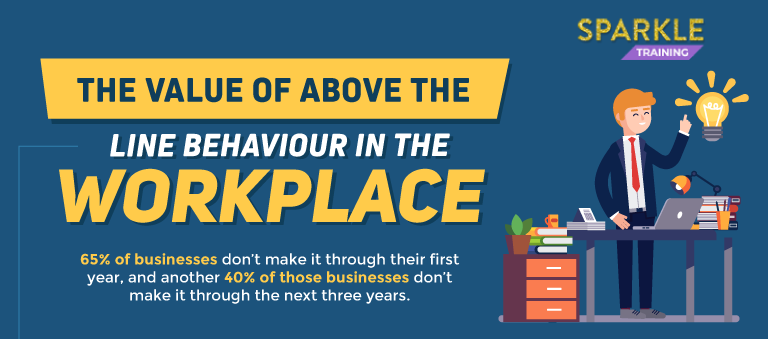A thin line separates success from failure. The only thing between the two is your choice. Whether your company becomes a success or completely fail will be decided when you choose between wallowing in victim thinking during hardship or demonstrate a more thoughtful and constructive manner. Creating a better future means taking the time to find the courage and get above the line.
Q2 hedge fund letters, conference, scoops etc
A study shows that 65% of businesses don’t make it through their first year while another 40% don’t make it through the next three years. Businesses meet the same fate if owners don’t take full responsibility for their actions but rationalize failures and lives in denial instead.
Sometimes below the line thinking is an automated response to uncomfortable situations but once it becomes a natural reaction to these circumstances, people eventually get stuck in a victim cycle and getting back on track is almost impossible if you don’t acknowledge that you’re functioning below the line.
Every person is different, and each situation is unique, everyone would reach a critical moment when they would recognize they’re stuck in a victim cycle.
When people pretend not to know that there’s a problem, deny its existence, or remain unaware of its effects, below the line thinking becomes a problem since tough issues remain unsolved. This line of thinking often gets coupled with an “it’s not my job” mentality which further avoids getting the problems addressed.
Below the line behavior makes small problems become even larger ones. Instead of moving forward, people responsible end up considering themselves “victims” and pointing fingers to others. They find themselves in defensive postures, denying responsibilities for poor results while wasting time bashing their employer, colleague, or the organization itself.
These victims are full of excuses. They site confusion to release themselves from accountability. After all, if they didn’t understand the problem or situation then perhaps they wouldn’t be expected to take action.
Victim culture comes from leaders who create fear and are only interested in hearing good news. This creates an organization with an unhealthy workplace behavior which then creates a breeding ground for drama and insecurities which ultimately ends in a decrease of productivity and an increase in employee turnover.
The Oz Principle recognizes the power of accountability and how it can lead corporations to the road of success. This principle was named after the well-known story, The Wonderful Wizard of Oz by Frank Baum.
Though it may seem like an ordinary children’s tale, this story of a young girl named Dorothy, going on an adventure in the magical land of Oz can also serve as an outline for improving individual and corporate attitudes towards responsibility.
In the story, some characters search for The Wizard of Oz as each wants certain things such as The Lion who seeks courage, The Tin Woodsman who searches for a heart, and The Scarecrow who desires wisdom but moving yourself above the line doesn’t involve searching for a wizard.
Individual accountability parallels the characters desires as above the line behavior means mustering the courage to see the internal barriers to success, finding the heart to own the feelings of personal responsibility for failure, and obtaining the wisdom to create solutions.
The main thing that business leaders must discover is the same thing that the lead character, Dorothy learned that the key to good results is exercising the means to do it.
Accountability lies in the effort of any company in improving the quality of their product, implanting good systems, empowering and building teams, having the right attitude, and getting the results.
Above the line thinkers believe life is about how you perceive it. Whether they receive the good or the bad, these people take ownership and responsibility for everything that happens.
Playing above the line can be challenging, at times it can be outside your comfort zone. At times, it can also be frustrating since you have to acknowledge the tough issues. While it’s easier to give up, those who are above the line or “victors” can still rise above their circumstances.
The victors are the one who looks for the good in bad situations and turns the negatives into a learning experience.
Having leaders who stay above the line can also drive and motivate the same behavior onto others. They show the way to accountability and responsibility by creating a culture of ownership and invest more effort into building resolutions instead of pushing the pressure downwards and shifting the blame.
Eventually, above the line behavior spreads which creates a positive work environment throughout the organization.
Instead of a blaming culture, introducing above the line thinking to the workplace can build a team’s confidence and create trust among them. A team that can embrace challenges will give you the time to focus on cultivating organizational processes and achieving goals.
To further explain how you can adopt this kind of mindset, here are the key takeaways of the infographic below by Sparkle Training:
- Building relationships are the key factor in successfully managing behaviors.
- We can’t control anyone else's behavior – we can only control our own.
- Never argue – instead, allow them to analyze the situation.
- Offer choices when assigning a consequence to a behavior.
To know more about how adopting an above the line thinking can help develop your workplace into a place to improve your team to reach their full behavioral potential, check out the full infographic below.







